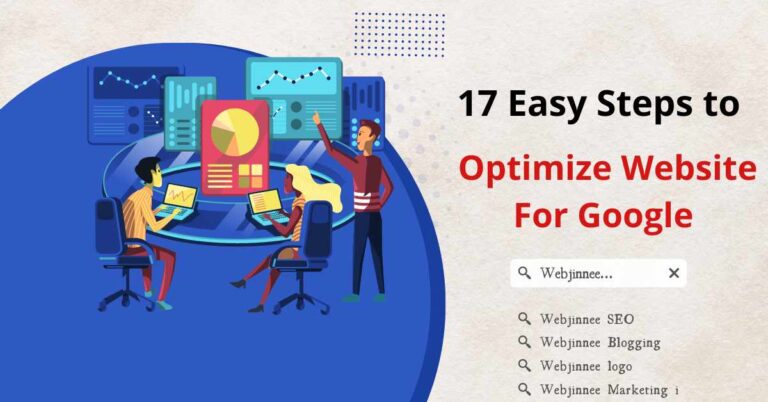17 Easy Steps to Optimize Your Website For Google Search: Powerful SEO Tricks
make the best or most effective use of Optimizing your website means to make the best or most effective use of it. To optimize your website effectively, you must first consider the function of your website. Do you sell products? Do you provide services? How does your website operate? What is your website telling your audience about your business?
Table of Contents
ToggleWhat Is SEO?
Search engine optimization or SEO is a marketing strategy that starts a process to optimize a website using link popularity, content relevance, and website’s technical configuration, such as SSL certification, XML sitemaps, website hosting, website load time, and FTP.
Using SEO constructively is one of the surest ways to optimize your website and enhance your website rankings on Google.
What is On-Page SEO?
On-Page SEO is basically a practice of optimizing individual web pages to rank higher on the search engine result pages.
This signifies that you have to optimize both content and the corresponding HTML source code and the best part about this is it generates effective traffic on your website with the most useful on-page SEO steps.
What is Off-Page SEO?
Off-Page SEO deals with the activities that are implemented outside the website to improve your ranking on the search engine results pages(SERPs).
It has everything to do with a social presence, link building and many more that doesn’t really have to be present on the page.
You May also Like:- Top 67 SEO Interview Questions and Answers? Most Asked (2023)
Optimize your website for Google Search
Optimizing Your Website On Google
To optimize your website simply means to make it more user and Google friendly. Optimizing your website is important because it can:
- Increase website speed
- Enhance user experiences
- Strengthen conversations and engage your audience
- Increase website visibility
- Drive more traffic
- Generate leads
- Improve brand awareness
- Develop and establish your brand identity
Other than strategically integrating SEO into your website with images, content, and keywords, other ways you can optimize your website include:

1. Registering Your Website With Google Business
Not only will registering your website with Google Business improve your local SEO, but it’ll make your business easier to find in your local area.
Registering your business with Google Business also helps your business build credibility in your community.
2. Ensuring Your Website Is Secure
When you enter a website address into your web browser and hit enter, do you ever notice the little lock to the left of the URL? That little lock represents an SSL certificate.
SSL certificates are crucial in the safety and security of your visitors. It also notifies sites like Google and lets them know your website is safe and secure.
Without an SSL certificate, your customers’ personal information, such as their name, address, phone number, birthdate, and credit card numbers, can be easily accessed by anyone.
3. Optimizing Your Images
Optimizing your images or photos before uploading them is important because it decreases their size and speeds up your webpage loading time.
An important tip to remember is that you can decrease your image size without decreasing image quality.
You can also optimize images on your website by carefully selecting your alt attributes.
Alt attributes are the text alternatives for your images when they cannot be properly displayed. These text alternatives also provide Google with information about what your images and add value to your SEO.
You May also Like:- Top 10 Digital Marketing Trends
4. Crafting Quality Content
Create rich, unique, and great content that informs, educates, entertains, inspires, or calls your audience to action.
Your content doesn’t have to be marketing based, driving them to make a purchase or pushing them into an action, but it does need to be thought-out, thorough, and serve a purpose.
Avoid creating short articles that are just there to serve the purpose of existing. Meaning, don’t just post content to have content. Post content that is meaningful, serves a purpose, and engages your audience.
5. Keeping Your URLs Clean And Concise
Using concise, descriptive URLs can enhance your SEO and optimize your website. Use URLs that are clean and to the point. Use readability as a key factor when deciding on your website’s URLs.
6. Creating Better Keywords
Choose keywords that are closer to your niche and use them naturally and strategically. Keyword research for blogs is ain’t easy but if you follow the right approach for keyword research.
Determining the right set of keywords is most important in the field of digital marketing. Picking up the right and relevant keywords will actually help your business to grow and achieve its goal, and then it will be viral.
Getting creative, but concise with your keywords will make your website stand out and easier to find among your competitors.
You May also Like:- 29+ Group buy SEO Tools in India

7. Writing Rich Meta Descriptions
Ensure you are utilizing your website’s meta descriptions and make them keyword-rich Meta descriptions are the 150-word snippets you see on Google that summarize a website before you click on it.
Meta descriptions are found underneath the title of a website in a Google search result page.
You can alter your meta descriptions by using Google Webmaster Tools.

Do Your On-Page SEO in Just 53 Steps and Improve Ranking.
Download On-page SEO Guide NOW!
8. Creating Unique, Clickable Meta Titles
You can have the richest, most informative meta descriptions on the Web, but without a solid title, no one will click on your webpage. This is where meta titles come in.
Meta titles or title tags are the titles you see above your meta descriptions on Google’s search results page. Title tags are just as important, if not more important, than your meta descriptions.
When writing your meta titles, keep them between 50 to 60 characters. Use specific, unique keywords that are relative to your brand or niche. Use your brand’s voice to embody your brand, and by all means, get creative and call your audience to action.

9. Building Reputable Backlinks
Backlinks are clickable links within your content that link to external (or internal) websites.
One way to build your backlinks is to use reputable websites that relate to the content you’re posting. Another way to build your backlinks is to ask a blog or another website to guest post content. Use backlinks wisely.
10. Creating A Social Media Presence
Creating a social media presence is just as important as building your reputation. Essentially, your social media presence is your business reputation online. You can build your social media presence by;
You May also Like:- 37 Best Time-saving SEO Tools in 2023: Free & Paid
11. Develop A Solid Marketing Strategy
Having a marketing strategy and posting schedule go hand-in-hand. Develop a marketing strategy that will not only engage your audience, but inform and entertain them.

12. Choose The Right Social Media Platforms
Using every social media platform in existence will actually harm your business instead of help. Understanding each social media platform’s purpose can help you decide which platforms will best suit your business.
Remember, social media platforms aren’t black and white. You can utilize different platforms in ways that other businesses normally don’t.
Also, consider the type of content you want to post and the audience you’re posting for. Some B2B companies choose to utilize LinkedIn. Restaurants and boutiques or retail shops choose to use Instagram as a platform to display their products.
When choosing which social media platforms will work best for your business, research your industry. Also research the social media platforms you currently use and see what is working and what isn’t working. Do your research and choose wisely.
13. Consistent Posting Schedule
Have a consistent posting schedule. A great example of a consistent posting schedule is: post content every Monday, Wednesday, and Friday at 10:00am and 1:30pm on the following social media platforms (insert the social media platforms you use here).
Include one image with at least one post and at least 50 to 100 words per post. The topic you choose to post about is entirely up to you.
Remember, it’s important to stay relevant to your business and research current trends that relate to your business. Keep your target audience engaged.
Creating a social media posting calendar can help keep you organized. There is plenty of software available for businesses looking to enhance their social media presence with content. Hootsuite is one of them.
You May also Like:- How to do Keyword Research for SEO: Never Fail Techniques
14. Add Value
Quality over quantity is one of the best philosophies for any business looking to build their social media presence. A few tips on how to add value to your content are:
- Avoid fluff and stuffing. Do not stuff keywords into your content and do not write fluff. Your customers will see through this tactic and deem your business as an unreliable source.
- Don’t post for the sake of posting or post to fill your website with content. Have reliable, valuable content your audience will find significant or useful.
- Give your content purpose. Does your content entertain, inform, inspire, educate, or make your audience think? If you’ve said no to these questions, rethink your social media marketing strategy. Have your content fulfill at least one of these goals.
15. Use The Right Hashtags
Using the right hashtags can promote your business and generate leads by guiding new customers to your website. When using hashtags, be concise and topic-focused. If you have a niche, focus on that and be precise.
16. Optimize Your Website Pages
It’s not enough to just optimize the technical aspects of your website. Optimize your “about” page too. This will lead potential customers to your site and give them the opportunity to learn about your business.
Be authentic, concise, and descriptive without being overly detailed.
You May also Like:- Top 10 SEO Tools to Boost Rank and Traffic in 2023 (Expert’s Choice)
17. Marketing Research
Before you develop a marketing strategy, research your market. It’s not enough to post interesting content and load your website with backlinks and keywords, you must do your research first.
But, who is your target market? Knowing who your market is important. You must know who you’re trying to reach before making the effort to reach an audience.
Consider demographics. Also consider the characteristics your target market has. Once you establish who your target market is, research them: what do they like? What they like to do for fun? What drives or inspires them?
Learn about your target audience. Are they parents? Are they married or are they single? Do they live alone, with family or friends? Do they have pets? What are their favorite brands or TV shows?
All this information is relevant in learning more about your target audience. The more you know about them, the easier it’ll be for your business to communicate with them and relate to them.



nice, great info! Thank you so much!
Thanks Reva